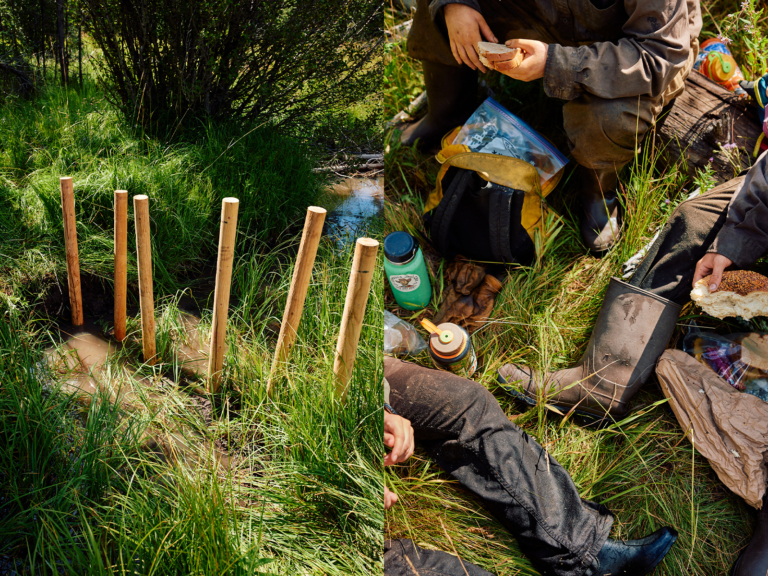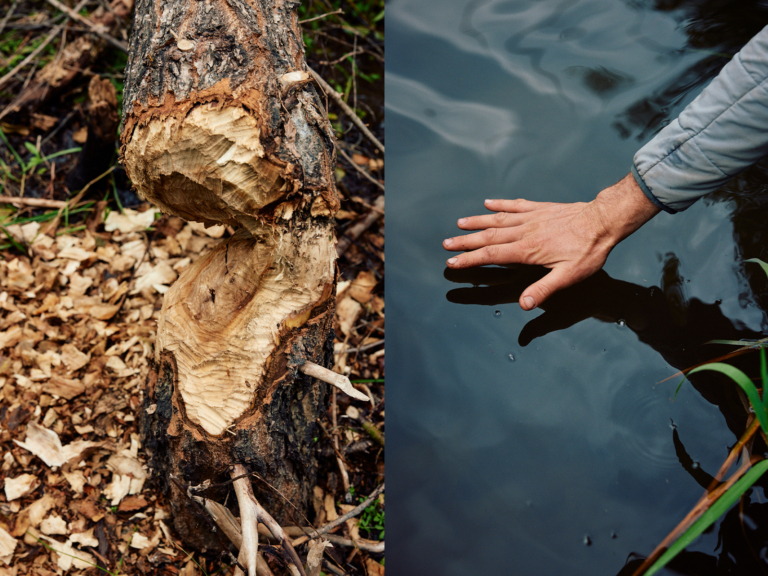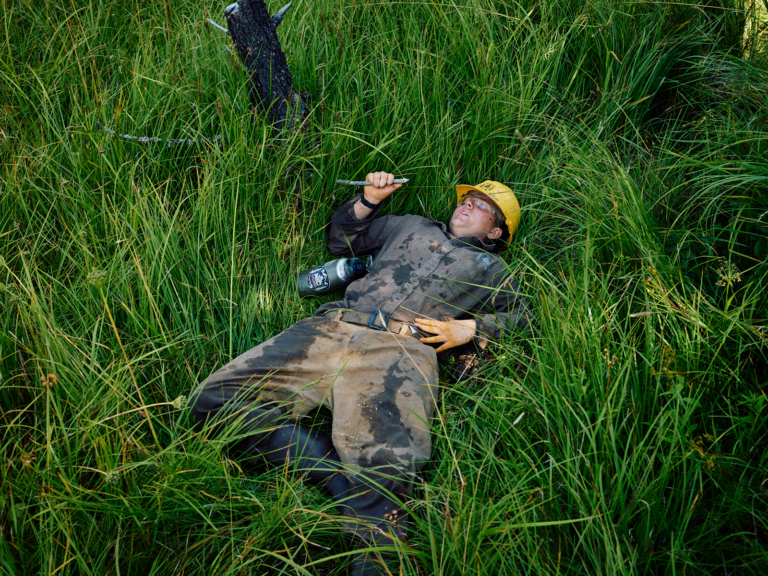Leave It to Beavers
Renewing rivers one rodent at a time.
Listen to the story
All photos by Greg Mionske
It’s barely above 50 degrees in a mountain meadow at the headwaters of the John Day River, deep in the Blue Mountains of Eastern Oregon. Dew soaks the ground, and the consensus is that today’s work conditions are already significantly better than yesterday’s. “It was the hardest day this year,” says Alex, a 19-year-old Northwest Youth Corps crew member sipping coffee from a mug covered in faded stickers. A random thunderstorm blew through yesterday morning and caught him without his rain jacket.
Weather and morale have improved significantly in the last 24 hours. Alex and the rest of the four-person crew from the conservation service and job-training program, as well as three Trout Unlimited employees, pull on mud-caked boots and waders, finish coffees and collect their tools—chainsaws, an errant bundle of shovels, towers of five-gallon buckets, branch loppers and wooden posts shaped like enormous pencils, shouldered two at a time.
Shifts start at 7 a.m., and although it’s early August, the cold air and wet dirt hint at autumn. After a short hike, work begins quickly. Buckets are filled with gravel and mud, while posts are driven into the soft earth of the creek bed.
The goal? To build artificial beaver dams, called Beaver Dam Analogs (BDAs), which are piles of mud, sedge grass, gravel and sticks placed in strategic locations along creeks in mountain meadows like this one.
Healthy meadows require much more than a singular creek running through a dry landscape; as such, the goal of this initiative—and others across the West—is to create a sprawling network of ponds, swamp and ground spongy with water and teeming with hundreds of species. Meadows smell green and wet, like dirt and life. Their complexity welcomes biodiversity. And at the root of healthy meadows are the unsung heroes of landscape resilience, habitat and river restoration, and carbon sequestration—beavers.
But North American beavers have had a tough go of it for the last 400 years, largely due to their systematic extermination at the hands of fur traders and, specifically, the Hudson’s Bay Company in the 18th and 19th centuries. Beaver pelts were extremely valuable and were especially desired for their “waterproof” characteristics. Currently, only a small fraction of the beavers that once existed in North America remain.
BDAs do not guarantee that beavers will come back; recolonization can—and does—happen, but it is more an exciting secondary benefit than a singular focus. Still, in the absence of actual beavers, BDAs are convincing imitations that can spur the processes needed to recreate complex, healthy meadows with improved spawning habitat for steelhead, Chinook salmon and other species. And, if all goes according to plan, a passing beaver might discover these human-made dams, complemented by the soft, pooling water they love, and think, “This is nice … but I could do better.” The hope is they’ll stick around. Dam mimicry techniques are used in areas where it’s almost certain beavers would have been historically active, so it’s not surprising they can set up shop and get to work quickly in a new BDA location.

Left: Sturdy wooden posts form the structural foundation of beaver dam analogs (BDAs). These frameworks replicate beaver dams, which help create vigorous meadow ecosystems.
Right: Three Northwest Youth Corps team members grab a bite under the sun while doing meadow restoration work along the North Fork of the John Day River.
Here in the upper reaches of North Fork Cable Creek, the lack of beavers is obvious—a singular creek channel has created a gorge through much of the valley. Beyond this valley, the legacy of logging, grazing, mismanagement and subsequent high-intensity wildfire is written across the landscape. As far as you can see, there’s a thick blanket of immature lodgepole pines punctuated by massive, blackened snags left by a fire that ripped through this valley in the mid-’90s. Human actions have changed this valley so profoundly that no living person will ever see it as it once was—dotted with old-growth ponderosa pine and Douglas fir.
Of all the things humans have done to impact these landscapes, killing some 400 million beavers to provide hats to aristocrats was among the most devastating. Prior to colonization and the mass trapping of beavers, dams would have dotted the lengths of small streams and tributaries across North America, creating a continent defined by wetlands. With a modern population of only 6–12 million beavers in the US (notoriously elusive, it’s difficult to determine precisely how many of them remain), reestablishing beaver colonies in mountain meadows via BDAs allows for a more hands-off management approach by humans.
“We saw a need for longer-term stewardship and adaptation because many projects have tried to do one-and-done restoration, but then 10 years later, people are back and doing another restoration technique,” says Levi Old, the Northeast Oregon restoration director for Trout Unlimited. This whole initiative, from the John Day River location to the use of the youth crew, was the brainchild of Old. “We’ve had this philosophy to try to do things more persistently over a shorter period of time and then, ideally, be hands off for good.”
Just upstream of where the crew works today is a perfect example of BDAs functioning as they should. Beavers found the work of last year’s crew and, in just under a year, have taken up residence and made their own improvements. What was once a deep, narrow channel that stored almost no water—the beaver equivalent of a mall parking lot—was now being dubbed “Beaver Shangri-La” by the crew.
What stood between the before and after was a hard-working team scooping gravel and mud and creating about a dozen small BDAs in strategic locations. Places once entirely on land are now under 4 feet of water. BDAs that were once a few feet long are now 30 feet across. While walking through the swamp created after last year’s dam building, we were surrounded by fire-scarred trees standing in nearly 3 feet of water—a clear indication of how deeply beavers had changed this landscape.

An aerial view of Cable Creek and the North Fork of the John Day River. If all goes according to plan, BDAs—and then beavers—will transform this landscape into a healthy meadow filled with interconnected rivulets, ponds and swampy, spongy ground home to diverse species.
It’s midday and muggy when Andy, one of the Trout Unlimited project managers, hands the reins for the next beaver dam analog over to El, a 19-year-old Youth Corps crewmember from Southern California. “El, how about you lead this one?” he says, trading his shovel for her branch loppers. After a moment, El begins providing direction, “You want to make sure the branches won’t wash out when water is racing through here,” she explains. She continues pouring the buckets that have been delivered by the others, pausing for a few minutes to reflect on the process and her next steps. “I have to remember to not think about it too much because I tend to overthink things,” she says. “I can’t try to, like, science it out. Beavers aren’t doing science. They’re just doing beaver stuff.”
The purpose of utilizing the Youth Corps crew for this job is to give them precisely this type of experience—making them squirm a bit as they try new roles and providing valuable experiences that only outdoor conservation work can provide. This program is designed for young people, combining manual labor with tactile lessons in conservation, ecology, public land stewardship and leadership. El and the rest of the crew have been working together since March; now that it’s early August, they operate like a well-oiled machine, taking up tasks as needed, quickly recognizing things that need to be done before anyone asks and engaging almost constantly in the types of conversations—inside jokes, banter, light heckling—that can only result from months of hard work together.
Regardless of the program’s good intentions, serendipity is the common denominator for the Youth Corps crew members who have ended up here. Alex joined after a few months of working at a factory near his Minnesota hometown. A simple Google search—”outdoor jobs, no degree”—introduced him to openings with the team.

The Northwest Youth Corp crew gets knee-deep in some serious muckraking along Cable Creek.
“I had never been camping for more than a week in my life,” he says.
El, meanwhile, found her way into conservation work immediately after graduating high school in 2021, when her mom encouraged her after seeing an online ad. “I was like, ‘Well, I’m not doing anything else, and it’d be nice to get out of the house,’” she recalls, almost smirking. In her first season, she joined an all-female crew and spent five weeks near Crater Lake, Oregon, logging out the Pacific Crest Trail with crosscut saws. “I think that’s a lot of people’s experience,” she says. “If they knew what they wanted to do, they wouldn’t be here. [A lot of crew members] are like, ‘I’m doing this because I’m in between things, or I don’t know what I want to do next.’ I think that it does help you figure out what your strengths and weaknesses are.”
The only returning member of the crew, Anna McCormick had the privilege of seeing the meadow before any BDAs were completed and now, again, with the presence of beavers drawn here in part because of that work. “With a lot of conservation work, you always just feel like a little tiny raindrop in a bucket,” says Anna, who’s also Northwest Youth Corps’ Oregon program coordinator. “Doing BDAs, you absolutely see tangible results. You can come back in a year and see a landscape become a floodplain with super complex beaver activity again—the water that was at my ankles is now at my thighs,” she says. “That’s a very real feeling. And I think that allows people to really understand the reasoning behind what we do.”

Left: If you build it, they will come. BDA construction aims to entice beavers to return to streams, tributaries and rivers. When beavers inhabit riparian areas, their dam-building helps create robust meadow systems.
Right: Believe in beavers. Levi Old of Trout Unlimited investigates the increase in water level in a beaver pool.
On the crew’s last day at the creek, Levi assembles everyone on an outcropping that affords a sweeping view of the watershed the crew has been working on the last few days. He asks the crew to share their observations of the valley below. The first to volunteer an answer is El. “Upstream, it’s drier, and there are more patchy shrubs,” she started, as Levi nodded in encouragement. “As you go downstream to where we were working, there’s less of a contrast between the dry, patchy areas and the bright green creek. It seems to meld together to be brighter green overall.”
I take a moment of observation for myself. From our perch, you can see the headwaters of North Fork Cable Creek, which forms within the deep folds of the mountains around us, its tiny snowmelt tributaries presenting as visible gaps in the lodgepole pines that blanket the hillsides. The creek below is cradled briefly by the pools created by the crew over the last few days, before rolling onward to the soft flow of the John Day. From there, it’s onto the Columbia and, finally, the ocean. Yet starting this week, at least in this valley, it will also course through a landscape made better by human hands—cheered by inside jokes and group meals, amidst rainstorms and heat waves, one bucket of dirt at a time.

El takes a breather in the tall grasses while building beaver dam analogs near Ukiah, Oregon.
Protect landscapes and communities near you.
Get involved and find an organization with Patagonia Action Works today.

